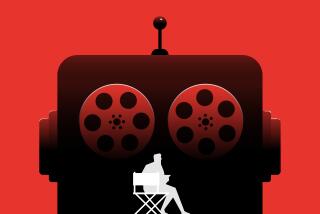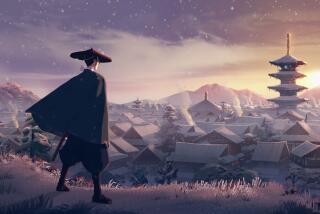Animation drawing new respect in Hollywood
In the beginning, there was Snow White.
Walt Disney’s lovely songbird made history in 1937, debuting in Hollywood’s first movie-length cartoon. It was an instant creative and financial sensation.
Today, 65 years later, her legacy will take center stage when three films are nominated in a new Oscar category -- best animated feature. The prize represents Hollywood’s official, if not belated, acknowledgment of animation as a bona fide art form.
But the films that made 2001 a record box-office year for animation hardly resemble their ancestral “Snow White and the Seven Dwarfs.” Lifelike computer-generated images have nudged aside traditional hand-drawn characters in such mega-hits as “Shrek” and “Monsters, Inc.,” both of which were nominated today.
What’s more, the animation industry is redefining itself at a furious pace, leaving everyone from financiers to artists wondering where the evolution of technology and tastes will lead. Although the new world of digital animation is creating opportunities for some, it is leaving others behind.
“The industry is in a very odd transition now,” said Tom Schumacher, president of Walt Disney Animation. “We’re making more animated movies than ever, they’re being made with different techniques, and the nature by which we make those movies -- in a garage or in a studio -- is all changing.”
And all this has prompted painful changes and choices not only for studio chiefs but for the hundreds of displaced animators who made their living drawing pictures by hand, not by computer mouse.
Jobs once considered essential for hand-drawn movies are no longer needed in computer animation, which is far less labor intensive than the traditional style.
“There’s been a huge amount of dislocation,” said Steve Hulett, business representative of the screen cartoonists’ union, which has seen its membership plummet from a high of 2,800 in 1996 to about 1,500 today.
Among the casualties is Steve Starr. He worked as a traditional animator at Disney for 26 years. When times were good, he commanded more than $130,000 a year. Last month, he was laid off and forced to sell his dream house.
“It’s very tough, there’s not much out there right now,” said Starr, 49, who plans to enroll in a community college course on computer animation.
Leading the digital charge is another former Disney animator, John Lasseter, creative chief of Pixar Animation Studios in Northern California. In 1995, Pixar and partner Disney were behind the movie that started the animation revolution -- “Toy Story” -- and continued it with last year’s “Monsters, Inc.”
Throughout Hollywood, Lasseter is revered as the modern-day Walt Disney. He believes digital animation is simply the logical extension of “Snow White,” when Disney used a new multi-plane camera to give more depth to his hand-drawn characters.
Studios still smarting from past expenses
Lasseter said that when he saw early computer graphics coming out of university research labs in 1980, his first thought was: “Wow, this is what Walt was always looking to do -- getting more dimensionality in his animated films.”
Still, he said, no amount of wizardry can make up for a lack of substance. “You need a great story populated by compelling characters that takes place in believable worlds.”
That’s what made “Snow White” the highest-grossing movie of its day, upstaged a couple years later by a movie called “Gone With the Wind.” For its artistic and technical achievement, “Snow White” was awarded a special Oscar.
Since then, other animated films have been nominated for, or received, Academy Awards, mostly in the musical or short-film categories. Only “Toy Story” and Disney’s 1991 “Beauty and the Beast” have crashed the top tier -- the former a nominee for best screenplay, the latter for best picture.
Nearly two years ago, however, with hit animated films flooding the market, the motion picture academy decided it was time for full-length features to compete head-to-head.
Actor Tom Hanks was tapped to chair the entry screening committee. Hanks, the voice of “Toy Story’s” lovable cowboy, Woody, was a natural choice.
Hanks believes audiences generally “accept anything in computer-generated movies, whereas with cell-animated movies they may say, ‘It’s just a cartoon.’ . . . The eye and mind are being dazzled by the pure technology and how the story is told.”
This is particularly true in an age when a generation of adults, teens and youngsters has been weaned on MTV, video games and out-of-this-world special effects in such big-screen groundbreakers as “The Matrix.”
Hanks was so seduced by the creative potential of computer animation that he is elbowing his way into the fray, developing and producing two projects for Universal Pictures. One is Maurice Sendak’s classic “Where the Wild Things Are.” The other is John Nickle’s lesser-known book, “The Ant Bully,” a “chance discovery” that Hanks said his 6-year-old son brought home from school.
But, as with any movie, there are no sure things.
Despite the record jackpots earned by “Monsters, Inc.,” DreamWorks/Pacific Data Images’ “Shrek” and Paramount Pictures/Nickelodeon’s “Jimmy Neutron: Boy Genius,” there also were three notable duds last year--Warner Bros.’ “Osmosis Jones,” Sony Pictures’ “Final Fantasy” and Disney’s traditionally animated “Atlantis.”
In fact, some studios are still smarting from the huge sums they poured into animator salaries and production facilities trying to replicate the success of Disney’s 1994 blockbuster, “Lion King.”
What they got for their money was a string of expensive flops -- including “Quest for Camelot” and “Titan A.E.” -- prompting a wrenching about-face.
Warner Bros. and 20th Century Fox, both of which launched full-scale divisions, virtually shuttered their animation operations, laying off hundreds of workers. Even market leaders Disney and DreamWorks dramatically retrenched as production costs and animator salaries soared amid heightened competition among the studios.
The studios are being lured back by the smell of the recent successes. This time, though, they are doing it with caution, mindful of the costly lessons of the past.
“We’re putting our toe in the water with titles that call out to audiences but we’re not committing to spending production money until we have a screenplay,” said Universal Pictures Chairwoman Stacey Snider. The studio, which last released an animated film in 1995, has three in the works, including one based on the classic children’s book “Curious George.”
Warner Bros. too is treading carefully. “Now, if we like a script, we’ll put a team together,” said Warner Bros. Chairman Barry Meyer. “We’re not going to lock into a fixed overhead where you’re looking to justify its existence and just push through projects.”
Traditional artists learn computer skills
Even studios that have never produced animated films are afraid to stay on the bench, including Disney-owned Miramax, known for its highbrow movies, and sister label Dimension Films, known for the horror spoof series “Scream” and “Scary Movie.”
“There’s no question about it,” said Miramax chief Harvey Weinstein, “there’s a huge audience for these movies.”
These days, animation for animation’s sake is not enough to justify the kind of big money gamble of the mid-1990s. Said Weinstein’s brother, Bob, who heads Dimension: “I’m not in the animation business, I’m in the movie business. To me, I’m buying the story and the talent.”
Disney also is reshaping its strategy to reduce costs and risk. Animation chief Schumacher said that despite the studio’s ongoing commitment to making animated movies, it plans to cut several hundred more jobs by the end of next year. That would leave roughly 1,000 people in the animation division.
Most will work on a project-by-project basis, rather than being paid under costly long-term contracts. Disney and rival DreamWorks also are cross-training many traditional artists so they can create on computers.
“I wouldn’t be surprised that within a couple of years, 95% of the traditional artists will be trained in computer skills,” said entertainment attorney Nancy Newhouse Porter, who represents a number of top animators. “Those who don’t, limit their options significantly.”
For some entrepreneurs, the cutbacks have opened new doors.
The cost of a digital work station -- the equipment used to scan drawings and store them on a computer -- has fallen from $50,000 in 1995 to as low as $2,500 today, according to some estimates.
Eric Huelsman, who teaches computer animation classes at the Los Angeles Unified School District’s Abram Friedman Occupational Center to displaced and employed studio artists, said: “I have a waiting list longer than my arm.”
The declining costs made it possible for Larry Whitaker to start his own business, Cornerstone Animation in Glendale, after his contract as a Disney animation supervisor was not renewed. Whitaker said the technology lets him experiment with a range of styles with a small core of artists.
Since last year, Whitaker said, Cornerstone’s revenue has jumped 15 percent, largely because major studios are farming out work.
Whitaker said animation production has become “lean and mean.” Studios, he said, can “use us to keep their overhead down.”
Even the big guys are gearing up their digital operations, hoping maybe to be the next Pixar.
Six months ago, “Jimmy Neutron” director Steve Oederkerk sank $6 million of his own money into building a 40,000-square-foot computer-animation studio in San Clemente, near his home in San Juan Capistrano. Oederkerk, best known for his live-action work, said that as the technology becomes more affordable, it creates vast opportunities outside the traditional Hollywood system.
‘You’ll see 19-year-old kids whipping up [computer-generated] movies and TV shows from their garages.”
Lines between old, new animation blur
John H. Williams, a “Shrek” producer, also is forming his own computer-animation studio in Los Angeles with $100 million in independent funding to co-finance a slate of movies with a soon to be announced studio partner.
“It’s a much more powerful way of taking you into alternative worlds with all these textures, complexities and depth,” Williams said of computer-generated imagery.
No one, of course, is predicting the demise of traditional animation.
“It’s like how you feel when someone sends you a typed letter versus a handwritten letter,” said DreamWorks partner Jeffrey Katzenberg, who as Disney Studio’s former chairman, oversaw the release of such traditionally animated hits as “Lion King,” “Beauty and the Beast” and “Aladdin.”
“There’s an intimacy that comes when you receive a handwritten note and that’s what is . . . so special and so singular about traditional animation.”
As the lines between old and new animation blur, so too do the boundaries between animated and live-action movies.
“Lord of the Rings” and “Gladiator” are just two examples of films with seamless special effects using the same computer technology as “Shrek” and “Monsters, Inc.”
And this leads some in the movie business to wonder whether Oscar’s new animation category comes too late.
“I think it’s a great thing that it draws attention to animation, but it’s a tricky category,” said Disney’s Schumacher. “And when I look down the road five years, it’s an even trickier category.”
Animation now and then
Disney’s “Snow White and the Seven Dwarfs” (1937) was Hollywood’s first movie-length cartoon, winning a special Oscar for artistic and technical achievements. In the intervening years, Oscars for animation have mainly been limited to musical and short-film categories. Only one animated feature, Disney’s “Beauty and the Beast” (1991), has been nominated in the best picture category. This year three films will be nominated in a new Oscar category -- best animated feature. Those nominated are last year’s financially successful, computer-generated films “Monsters, Inc.,” “Jimmy Neutron: Boy Genius” and “Shrek.”
More to Read
Go beyond the scoreboard
Get the latest on L.A.'s teams in the daily Sports Report newsletter.
You may occasionally receive promotional content from the Los Angeles Times.











